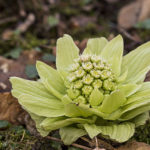Gallery:
- Japanese butterbur
- Japanese butterbur leaf
- Japanese butterbur flower head
- Japanese butterbur stems
- Japanese butterbur stems
Common names:
fuki, giant butterbur, Japanese sweet coltsfoot, creamy butterbur
Scientific Name:
Petasites japonicus (syn. Nardosmia japonicus)
Description:
Japanese butterbur is an herbaceous, rhizomatous perennial in the Asteraceae (sunflower) family. The plant has large (4 feet wide!) kidney-shaped leaves that have woolly undersides and grow on stems that are 3 to 4 feet long. The white or cream-colored flower clumps emerge before the leaves.It needs both male and female plants to produce seeds, but the plant spread mostly through rhizomes (underground stems) that spread out in all directions.
Life cycle:
Height of mature plants
up to 6 feet tall
Flower color:
white to pale-yellow
Bloom time:
March – April
Look-a-likes:
Japanese butterbur looks very similar to its relative, common butterbur (Petasites hybridus), which can also be invasive. Common butterbur has pink to purple flowers and the leaves are a bit smaller than Japanese butter and only grow to 1-2 feet across (rather than 3 to 4).
Habitat:
Japanese butterbur requires consistent moisture, and grows best in partially-shaded streamside or lakeside areas, meadows, and fields.
Impacts:
Japanese butterbur is often planted as an ornamental, but if the plant roots are not contained, its underground stems allow it to spread rapidly, especially in moist streamside areas. The large leaves can shade out other plants, leaving bare ground, which can lead to erosion problems.
Noxious Weed Listing:
- WeedWise:
- State of Oregon: not listed
- State of Washington: not listed
- Four County CWMA: Class W
- Columbia Gorge CWMA: Class B
Origin:
China, Japan, Korea
Links:
City of Portland Alien Plant Invader
Missouri Botanical Garden Weed Profile
University of Arkansas research and Extension Service weed profile





